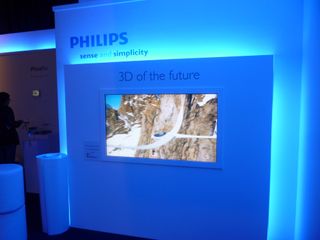Philips to launch glasses-free 3D TV in 2013
Jaw-dropping prototype shown off in Berlin

Pleasing news for all you 3D sceptics out there - Philips is set to launch the world's first glasses-free 3D TV as early as 2013.
That's according to Maarte Tobias of Dutch company Dimenco, which is developing the lenticular glasses-free technology on Philips' behalf.
A working prototype of this TV is on display in the Philips hall at IFA, and it really is truly impressive.
Philips has displayed a glasses-free 3D TV prototype at IFA every year since 2007. But only now has the technology looked so genuinely fantastic, and Tobias says that not only will the finished product go on sale in the next three to five years, but a professional monitor like the one on display at the show will be going on sale within months.
The technology works very much like a lenticular photograph where the illusion of depth is created by the use of a series of interlaced strips at different angles.
In development
Dimenco is made up of a team of ex-Philips engineers who left the company when it decided not to further pursue the use of lenticular panels in 3D TVs. They're now developing the tech, in conjunction with Philips, and have made several breakthroughs in making the tech viable.
Get daily insight, inspiration and deals in your inbox
Get the hottest deals available in your inbox plus news, reviews, opinion, analysis and more from the TechRadar team.
The underlying panel on display has a resolution of 4K (four times 1080p) which is the minimum needed to produce a 1080p 3D picture once the lenticular lens has split the light from the CCFL LCD panel underneath.

"As a TV people will be able to buy this in three to five years, and as a monitor it'll be available in a few months. This panel you see today is a 56-inch panel but the one we're bringing to market will be a 52-inch model," said Tobias.
"How it works is that we put a lenticular lens over the panel which creates a left view and a right view, each eye then sees a slightly different image and that's why you perceive 3D. The panel we have here today uses CCFL LCD but it will work just as well with LED."
Flaws in the system
While the 3D panel was striking – it was displaying full-motion movie footage and looked flawless from directly in front - there was a definite shimmer when walking off axis, and the panel blurred considerably - with all 3D effect being lost - when viewed from an acute angle. Tobias said this will have to be overcome before the TV can be brought to the consumer market.
"There are some big innovation steps still possible, the quality will be hugely improved especially when it comes to the consumer market," he said.
Tobias also said that the Dimenco/Philips lentcular 3D display is currently the most advanced glasses-free TV in the world.
"It is important to build further on the lenticular technology. I think this will be the future – 3D without glasses."
The Dutchman also added that the lenticular panel currently uses specially created source material and isn't compatible with standard 3D Blu-ray, for example, but that by the time the product hits the shops, it will all be standardised and compatible with all 3D formats.
And of course, Philips is not the only company currently researching lenticular 3D TV panels – Toshiba is rumoured to be working on the tech, and no doubt the other big hitters are too. But still, no one has yet demonstrated such an advanced model – it's just a pity our 2D photograph can't do it justice.
James was part of the TechRadar editorial team for eight years up until 2015 and now works in a senior position for TR's parent company Future. An experienced Content Director with a demonstrated history of working in the media production industry. Skilled in Search Engine Optimization (SEO), E-commerce Optimization, Journalism, Digital Marketing, and Social Media. James can do it all.
Most Popular

